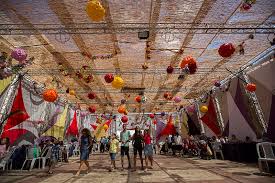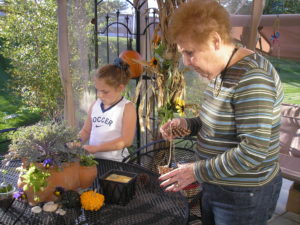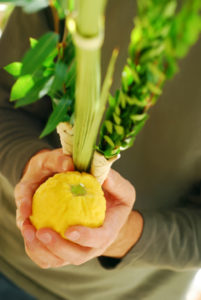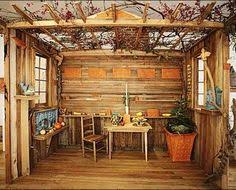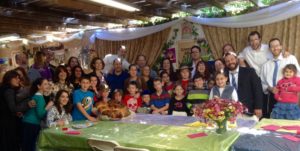Sukkot Celebrates Bountiful Harvest with Family, Friends, Food & Fun
The week-long festival of Sukkot, the Hebrew word for “booths,†begins when the sun goes down tomorrow night (September 23-30), and is considered one of the happiest times in the Jewish calendar. When else are we commanded to build a hut-like structure, called a sukkah, in our backyard, decorate it with fresh fruit, gourds and other Judaica ornaments, and get to eat our meals alfresco and even sleep under roofs of branches open to the stars?
This joyous holiday is also called, “Feast of Booths,†and comes 15 days after the Jewish New Year and five days after Yom Kippur. Sukkot is the first harvest festival of the year, commemorating the 40 years the Israelites wandered in the desert after their exodus from slavery in ancient Egypt on their way to Canaan, the Promised Land. While traveling through the wilderness, the Jewish people would live in a makeshift sukkah and eat every meal in there.During this time of the temples in Jerusalem, people came to Jerusalem on a pilgrimage (called an aliyah leregel– ascending by foot) and offered fruits and other gifts as sacrifices in the temple.
Today, people are still flocking to Israel, only now families come from all over the world to join in the mass celebration. These temporary dwellings pop up literally everywhere in Israel, from a portable wooden box assembled on a small apartment balcony to an elaborate cutom-built structure at a luxury hotel. Kids are off school, some businesses close, and families rejoice in parades, activities, singing, dancing, and of course, eating. Ah, eating, our favorite pastime. Sometimes referred to as the Jewish equivalent of Thanksgiving, Sukkot is a time to indulge in the bounty of foods that are harvested in the autumn, such as, pumpkin and squash soups and dishes made from apples, pears, sweet potatoes, carrots, and other root vegetables. Cabbage, grape leaves, zucchini, squash, and peppers stuffed with rice, meat and herbs are symbolic of a “full†harvest and the “hidden†messages inside many of our rituals and traditions. Another mouthwatering treat is tzimmes, a honey sweetened root vegetable and dried fruit stew also commonly eaten for Rosh Hashanah for the sweet New Year.
Sukkot is a special time when everyone comes together, especially in the Holy Land at the Jerusalem March, the largest and oldest parade in Israel. This extravaganza represents marching bands, IDF soldiers, street artists, and dance groups with nearly 60,000 people in attendance, including 10,000 tourists from 35 countries.
We don’t have to live in Israel to celebrate Sukkot at its fullest. For seven days and nights, we eat all our meals inside the sukkah and basically make this hut our home. Located under the open sky, the sukkah is made up of at least three walls and a roof of natural vegetation—typically bamboo, pine boughs, willow or palm branches. Even though some people go all out when building their sukkah, installing ceilings fans and strands of lightbulbs across the frame, this temporary dwelling is not meant to be fancy or withstand the strongest winds and elements of nature. The sukkah represents the fact we as humans are fragile and a small part of a much larger world. Sukkot is a time to appreciate the shelter of our homes and our bodies.
Another Sukkot observance is the taking of the “Four Species” of plants, representing the four different kinds of Jews. The Etrog (citron) has a good taste and fragrance and represents a person with both wisdom (Torah learning) and good deeds; the Hadassim (myrtle twigs) has a good fragrance, but is inedible and represents a person who has good deeds, but lacks wisdom; the Lulav (palm frond) is edible, but has no smell and represents the person with wisdom, but without good deeds; and finally the Aravot (willow twigs) has neither taste nor smell. It represents a person with neither good deeds nor Torah learning.
On Sukkot, we gather these four species, bind them, recite a blessing over them, bring them together and wave them in all six directions: right, left, forward, up, down and backward. Sukkot reminds us to build relationships with all kinds of Jewish peopple for the sake of uniting as one nation.
Here’s a blog I wrote about how to build a sukkah and observe these holy traditions in your own backyard. Again, you don’t have to attend synagogue to be close to God. Look up, down, and all around. God is everywhere.
Everyone is invited to the annual Yari family Sukkah Party on Sunday, September 30th, 10:30- a.m.-12:30 p.m., Â featuring a delicious brunch, balloon art, moon bounce, and lots of fun for the whole family. The Yari’s claim to have the largest residential sukkah in St. Louis and aim to bring a taste of Jerusalem to the heart of University City where they open their home to Jewish family and friends for Shabbat, holidays, challah making, and many simchas!
Chag Sameach!
